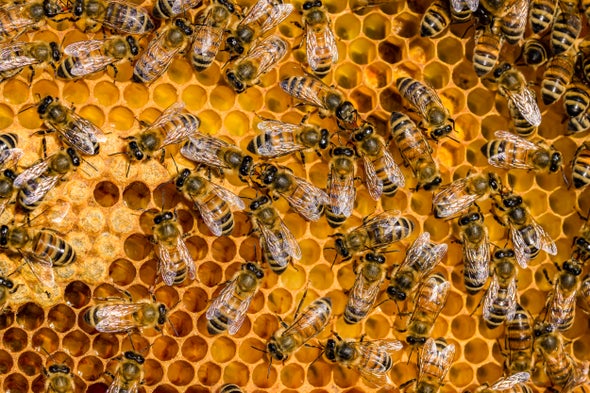If the bee disappeared off the surface of the globe, then man would have only four years of life left.
No more bees, no more pollination, no more plants, no more animals, no more man.

As the CV pandemic makes grimly clear, cities are arguably humanity’s greatest invention. But densely populated metropolises also make us vulnerable to the rapid spread of disease.
Yet humans aren’t the only species that face this problem. Honey bees have lived social lives for tens of millions of years, making them some of the oldest veterans in the battle against contagion. And over time, natural selection has given them an impressive array of strategies for mitigating transmission within colonies.
Bee pandemic: Varroa destructor
Sophisticated as they are, however, these strategies are not enough to stave off every threat. Honey bees are battling their own global pandemic, for which they were utterly unprepared.
A parasitic mite, aptly named Varroa destructor, originally infested only colonies of Asian honey bees, Apis cerana, but jumped to infect Western honey bees, Apis mellifera, the species that dominates the modern commercial pollination around the world.
The mite probably jumped from Asian to Western bees sometime in the 1950s, with the first reports in 1957 in Japan, then 1963 in Hong Kong.
Humans facilitated this host expansion by keeping A. cerana and A. mellifera in artificially close proximity within apiaries, then transporting newly infested colonies within and between countries.
And V. destructor has been living up to its name. Today, it has spread to every region where honey bees are kept except Australia and a handful of remote islands, quickly becoming a global pandemic and the single biggest pathological threat to honey bee health.
Left untreated, a colony will typically die from the mites within two years. These and other pathogens, plus pesticides and poor nutrition, have forced beekeepers to struggle to keep their colonies alive. Of the 2.6 million honey bee colonies in the U.S., over half of them are infested with V. destructor.
And that’s only counting those that are tested and reported; the actual numbers are likely much higher. Beekeepers have still managed to slowly increase the number of colonies they keep, on average, but at a substantially higher cost. And those increases are being outstripped by rising pollination demand.
No remedies against V. destructor
Western honey bees did not co-evolve with V. destructor, and the Western bees lack the behavioral traits that Asian honey bees have, like permanently entombing mite-infested brood and, perhaps the most extreme strategy, “social apoptosis,” where the brood are so sensitive to parasitization that they outright die upon infestation, sacrificing themselves to prevent the mite from reproducing.
Mite-fighting traits exist in commercial honey bee populations as well, but they are not enough to confer adequate resistance without intense selective breeding.
Beekeepers and scientists are doing what they can to breed Varroa-resistant genetic stock, but it is costly and laborious work that is not viable for most businesses.
What’s more, a handful of commercial queen producers in the U.S. rear and distribute millions of queens, the reproductive females that lay all the eggs in a colony; and those producers don’t rigorously breed for mite resistance, so the beekeepers’ colonies typically won’t be mite-resistant either.
Bee hives being miticided
As a result, in modern commercial apiaries with densely packed colonies, beekeepers need to medicate their hives with miticides to maintain a profitable business.
Colonies are often so close together that bees will drift into the wrong hive by accident, making the spread of parasites and pathogens inevitable.
The most extreme example of this is when, every February, around two thirds of U.S. colonies (1.5–2 million) land in California for almond pollination.
Under those circumstances, one heavily infested hive would quickly spread its mites to all the neighboring hives and beyond. So far, routine miticide applications are sufficient to mitigate this problem. But, as with the sustained use of any biocide, mites are becoming resistant to beekeepers’ treatments.
Another parasitic mite on the rise
And if that wasn’t bad enough, another genus of parasitic mite, called Tropilaelaps, is poised to start another pandemic.
It, too, recently jumped from another honey bee species, the Asian giant honey bee, to the Western honey bee. First identified on rats near honey bee colonies in the Philippines, it has now expanded into colder regions of mainland Asia, where climates are very similar to the U.S.
Where Varroa and Tropilaelaps coexist in colonies, Tropilaelaps outcompetes Varroa, causing even greater damage and deformities.
So far, Tropilaelaps mites have not spread to other continents, but their global dispersal is probably only a matter of time.
It is not that uncommon for whole colonies of bees to hitch rides overseas by nesting in cargo or on the ships, carrying pathogens and parasites with them.
Other invasive pests have likely also reached North America by this route: The Asian giant hornet, Vespa mandarinia, has now been sighted in British Columbia and Washington, with at least one established nest being identified and eradicated.
Canada imports tens of thousands of honey bee packages (starter colonies) from countries like Australia, New Zealand and Chile, so Tropilaelaps could enter North America via any of those countries, too.
A globalized economy and our systematic destruction of the natural world create the perfect conditions for pathogens and parasites to establish novel hosts and quickly spread overseas.
We must become better prepared for emerging diseases to be a mainstay risk in the modern world. They are a persistent threat to our own health, the health of our livestock and that of the wildlife that may inadvertently catch the spillover.
As we have tragically witnessed with the current health crisis, emerging diseases are killing us, and they’re killing our bees, too. Yes, humans and animals aren’t prepared for pandemics. [Scientific American]












It’s not aptly named. Mr. Varroa would not have liked to have beeenassociated with the destructor os bees.